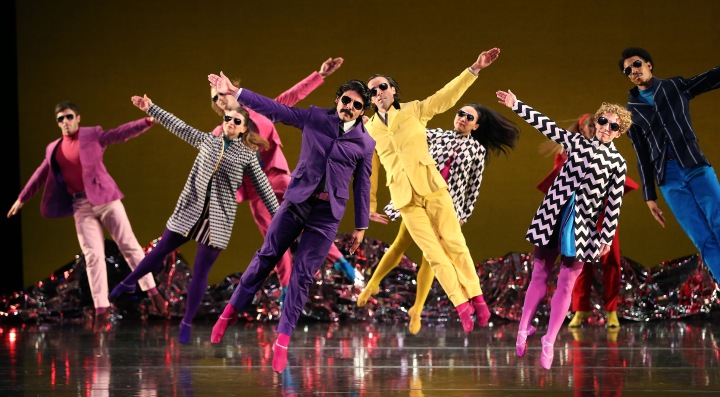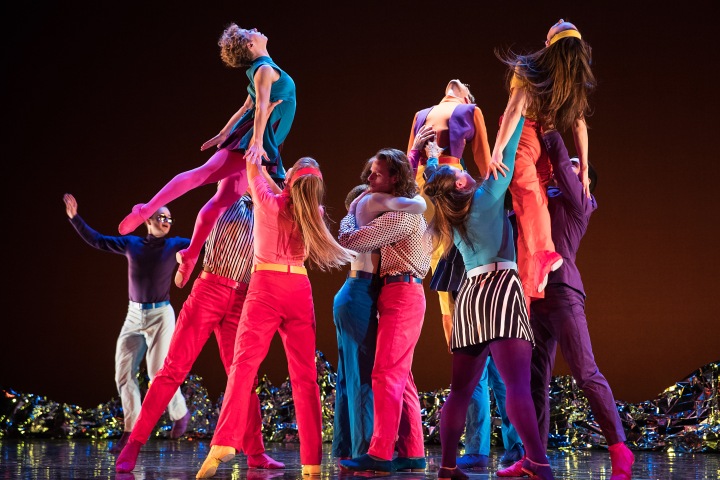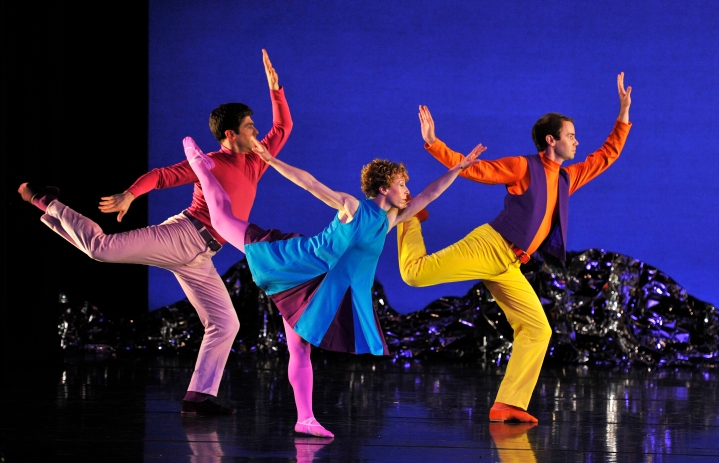Sergeant Pepper-mania
Mark Morris Dance Group
Kennedy Center Eisenhower Theater
Washington, D.C.
November 14-16, 2019
By Lisa Traiger

The choreographer takes his inspiration from music. In his 40-year career as a dancer and dancemaker, he has created more than 150 works. Music has been his constant impetus and companion in his creative process. In performance, he insists on bringing his own music ensemble to accompany the dancers.Mark Morris dances are emphatically watchable, easily digestible, eccentric, and smartly witty. He so proficiently pairs music and dance, costume and set — with a cadre of collaborators — that it’s hard to have a bad night at a Mark Morris Dance Group performance. This is most often due to the deep musical and creative bond he has with long-time musical collaborator Ethan Iverson.
From his gorgeously lyrical masterpiece (L’Allegro, il Penseroso ed il Moderato ) to the archly sardonic (The Hard Nut, his version of The Nutcracker) to wildly dramatic (Dido and Aeneas), the musically glorious (Falling Down Stairs), the intellectually bracing (“Grand Duo”) and the wicked fun (his very early “Lovey” danced to the Violent Femmes), Morris’s best pieces compel the body to sing, and the movement, steps, formations, phrasing appear as if they were born just for a particular piece of music.
Thus, when he was approached to make a piece to the Beatles, he didn’t play it straight and just set dancers in motion to the sterling and singable recordings of the Fab Four. The commission offered by the City of Liverpool asked for a dance to commemorate the Beatles’ groundbreaking Sergeant Pepper’s Lonely Hearts Club Band album on the occasion of its 50th anniversary in 2017. The hour-long work, now on a North American tour with the choreographer’s eponymous Mark Morris Dance Group, is currently on stage at the Kennedy Center’s Eisenhower Theatre, where it’s awash in accolades from a boomer audience that can’t get enough of the idea of high-brow dancing to the Beatles.
And the vividly colored, smartly cut early 1960s costumes, thanks to designer Elizabeth Kurtzman, and Johan Henckens’ bronze crinkled mylar set — a nod perhaps to Warhol’s “Silver Clouds,” which populated Merce Cunningham’s “Rainforest” — allow Morris’s clean, simple choreographic choices to shine.
In fact, not once is a recorded vocal from John, Paul, George, or Ringo heard. Iverson has rearranged several of the album’s iconic songs — the title track, “With a Little Help From My Friends,” and “When I’m Sixty-Four” — for an ensemble of six playing sax, trombone, piano, keyboard, percussion, and the electronic space-agey theremin. If you know the album — and anyone born before 1967 must know at least some of it — you’ll hear baritone Clinton Curtis sing a few standards in a mostly non-Beatlesque way. The others? You just have to sing along in your head as the music plays.

On additional sections of the score, Iverson riffs on musical ideas of the period that may or may not have influenced the Beatles. Iverson’s musical addendums peppered into the 13 sections include an adagio; an allegro drawing from an offhand trombone phrase in “Sgt. Pepper”; a scherzo inspired by Glenn Gould, Petula Clark, and a chord progression from the album; and a cadenza that reflects the Beatles’ references to European classical music. They are a nifty way to avoid treacly nostalgia while still honoring the innovative band’s contributions.
The opening notes of the piece strike the final chord on the album, a familiar sound for those who have listened to it. The opening choreography features an unwinding clump of dancers that spirals outward filling the stage with a jumble of bold jelly-bean colors — vibrant yellow, tangerine, aquamarine, grape, and hot pink tailored sharply into mod slacks, skirts, turtle necks, and jackets. A little skip-hop step with the arms carefully placed reflects a walker’s gait — the walk across Abbey Road maybe? The company of 15, plus five apprentices, imbues these introductory phrases with a heightened naturalness as their legs pierce the air, arms slicing, palms outward, opened to the audience.
After that initial unwinding moment, the “Magna Carta” section introduces historic figures who make an appearance on the colorfully iconic album cover — from Albert Einstein to Marilyn Monroe to bluesman Wilbur Scoville to boxer Sonny Liston — at each name, a dancer jogs in and takes a pose suggestive of the personality of the figure.
Morris cares little for traditional virtuosic tricks. In fact, his technique is closer to that of founding mother of modern dance Isadora Duncan’s runs, skips, jumps, and hops than the codified virtuosity of either ballet or mid-century moderns like Martha Graham and Paul Taylor. His early training in Balkan folk dances also shows in circle formations, hand-holding pairs, and short lines of dancers, linked and maneuvering in unison.
In Morris’s works a sense of humanity prevails. Yet, the company has changed over time, from a mixed-bag bunch of highly proficient dancers of various heights, body types and backgrounds, to today’s company, which is not necessarily less diverse, but its members are far more similar physically. Everyone is trim, with long legs and an aesthetically pleasing dancerly quality, you can see their ballet backgrounds in the less weighty earthy attack. It makes for a more uniform, although far less interesting looking company. Morris still prizes dancers who are fully themselves on stage and who strive to emulate the human condition in performance.
The evening — like much of Morris’s choreography — plays astutely with theme and variation. Morris enjoys having dancers hold hands, link arms and march or walk in mini regimental rows, four abreast, a nod to the Fab Four. In a series of lovely adagios, one partner in a male-female or same-sex couple lifts the other, whose legs stick straight down in a modest straddle, toes pointed. It’s a simple but distinctive motif. Other repeated phrases include some small traveling skips, skitters and leaps, a big bursting jump with arched backs — cheerleader-y — and some simple turn sequences. Morris shuffles and reshuffles these motifs in ways that make the viewer feel smart — “Oh, yes, I saw that before. I see what you’re doing here” — using a different structure, formation, number of dancers or even sequential or canonic counts.

Morris also winks at the psychedelic era by putting his dancers in mirrored sunglasses on occasion — those “kaleidoscope eyes” from “Lucy in the Sky With Diamonds,” and with some moments late in the work, he lets them loose for free form movement. But the work is conscientiously structured, not improvised. Late in the piece, as “Penny Lane” — not on the album, although originally written for “Sgt. Pepper’s” — plays, the dancers enact an old-fashioned pantomime to the lyrics — getting into a barber’s chair, driving a car, offering a queenly smile and wave, etc. Audiences enjoy the humor and again see the Morris style at work. Other references he throws in might be less obvious such as the mudra, or Indian hand gesture of thumbs up used in the Indian dance form bharata natyam. But for Morris it reflects his love for and study of Indian classical dance. There are plenty of other “Easter eggs” in any Morris work; Pepperland is no exception.
Interestingly, as tuneful and musically interesting as Pepperland is, especially if you read the composer’s program notes, the piece doesn’t come close to a Morris masterwork. The choreographer must love the music completely to attain such a sublime aesthetic level. He’s created dances to Mozart, Britten, Purcell, Bach, Prokofiev, as well as country music, punk rock, Indian ragas and Azerbaijani mugham songs, to name a very few, so a bit of Beatles is no stretch for his rangy musical tastes. But Pepperland simply doesn’t sing in the way his best works can. It doesn’t feel like Morris is all-in. Choreographically, the work is as adept as any of his most recent, showcasing the strengths and talents of his well-honed company, his unparalleled skill in structuring dances that move easily. While it’s unfair to expect a masterpiece every season, Pepperland feels more like an assignment completed: Liverpool wanted a Beatles ballet? Well, Morris went ahead and delivered one.
Finally, for all the bright colors and the tuneful Beatles songs, the oft peppy, upbeat dancing, the whirl of shifting musical and costume colors, Pepperland emanates a surprisingly sober, even somber, tone behind those mirrored sunglasses the dancers wear. The initial opening clump, turns back in on itself at the end, the dancers collapsed, exhausted, overcome as the music rumbles. When asked why he had sad sections in the piece during the post-show discussion on opening night, Morris was, as usual, sharply glib: “Well, it’s a fucking sad world, that’s why.” Then he waved goodnight, tossed his scarf over his shoulder and swanned off.
Photos courtesy The Kennedy Center, top by Gareth Jones, middle by Mat Hayward,
bottom by Robbie Jack.
This review originally appeared on DC Metro Theater Arts and is reprinted with kind permission.
© 2019 Lisa Traiger


 I heard chatter in the lobby after the show that tap was not an expressive medium to carry forth the heavy message this show imparts. But tap is exactly the appropriate genre to pull back the curtain on America’s long-standing racist and hate-filled roots. With its heavy-hitting footwork by Webb and Edwards, its lighter more nervous tremors from Wilder’s solo performed in prison stripes, to the chorus line of leggy beauties from the Divine Dance Institute, tap is exactly the right means to express the anxiety, fear despair and hope these men represent as they parse through the history of slavery, racism and discrimination in America. REFORM, in ways, reflects and moves past some of the methods and materials in the groundbreaking 1995 musical Bring in ‘da Noise, Bring in ‘da Funk, of which Wilder is an alum, but REFORM feels more like a sequel, taking audiences further by immersing them in the ramifications of black-men’s actions that are still statistically more likely to land them in jail or dead, than their white counterparts. REFORM is difficult to watch and doesn’t leave audiences with much uplifting. Rather it’s a call to both acknowledgement — particularly for privileged audiences, white or otherwise — and action.
I heard chatter in the lobby after the show that tap was not an expressive medium to carry forth the heavy message this show imparts. But tap is exactly the appropriate genre to pull back the curtain on America’s long-standing racist and hate-filled roots. With its heavy-hitting footwork by Webb and Edwards, its lighter more nervous tremors from Wilder’s solo performed in prison stripes, to the chorus line of leggy beauties from the Divine Dance Institute, tap is exactly the right means to express the anxiety, fear despair and hope these men represent as they parse through the history of slavery, racism and discrimination in America. REFORM, in ways, reflects and moves past some of the methods and materials in the groundbreaking 1995 musical Bring in ‘da Noise, Bring in ‘da Funk, of which Wilder is an alum, but REFORM feels more like a sequel, taking audiences further by immersing them in the ramifications of black-men’s actions that are still statistically more likely to land them in jail or dead, than their white counterparts. REFORM is difficult to watch and doesn’t leave audiences with much uplifting. Rather it’s a call to both acknowledgement — particularly for privileged audiences, white or otherwise — and action.


leave a comment